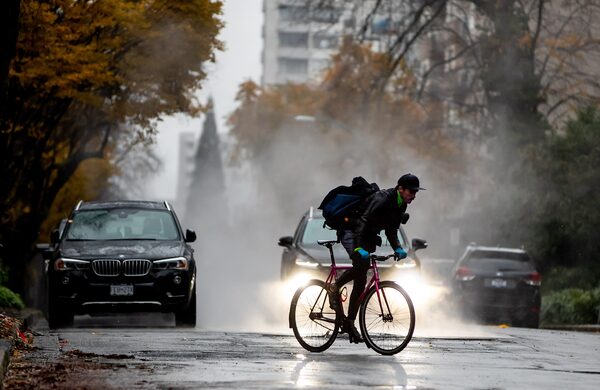
Vancouver cycling advocates were hopeful some big changes were coming, but now they’re disappointed after the ABC Vancouver-dominated council voted in favour of a staff report recommending big changes be done later, after it becomes clearer how traffic patterns shift once the new Broadway subway extension opens in 2026.DARRYL DYCK/The Canadian Press
Vancouver cycling advocates had hoped for a New York- or Paris-style transformation on the city’s major east-west commuter route, a reimagining of Broadway with less room for cars and two lanes dedicated to “active transportation” after current subway construction is finished.
Instead, they’re disappointed after the ABC Vancouver-dominated council voted in favour of a staff report recommending the big changes be done later, after it becomes clearer how traffic patterns shift once the new Broadway subway extension opens in 2026.
And they say the interim plan, to reduce traffic capacity from six lanes to four by reinstating parking along the current construction-impeded stretch, is going to be difficult to change in the future.
“There will be no easier or more cost-effective time to do it than now,” said OneCity Councillor Christine Boyle, expressing the same sentiments as about 40 speakers who showed up last week to vouch for the bike-lanes option.
That has kicked off another intense debate in Vancouver about what the balance should be between encouraging more cycling and accommodating existing car and truck traffic.
Active-transportation advocates say the city is abandoning its progressive efforts on cycling and giving in to the status quo for cars.
“There were 40 speakers who said it would be crazy not to do this. But a group of council had made up their minds. That sends a very clear message,” said Jeff Leigh, a representative from the advocacy group HUB Cycling. “I don’t think Vancouver is seen as a leader in cycling any more.”
But others say the situation isn’t as dire as the cycling advocates make out.
ABC Councillor Lenny Zhou says surveys showed people’s top priority was better pedestrian spaces on Broadway.
And the city’s head of engineering, Lon LaClaire, said altering the street radically is a “big, bold move and that’s what you want to do when you see everything is working. It’s not the right time for Broadway.”
At the moment, Broadway’s traffic – between 1,100 and 1,700 vehicles per rush hour in each direction (31,000 a day measured at an eastern intersection) before the SkyTrain subway-extension construction started two years ago – has been reduced considerably as drivers opt for other routes to avoid the constantly changing slalom course along the road.
The department doesn’t have any statistics on what the traffic volumes have been during construction.
There’s also been no parking along Broadway for the four kilometres between Main and Arbutus streets for the last two years.
“Now we’re looking to get the parking back to the businesses,” said Mr. LaClaire.
One local business-improvement association and the Greater Vancouver Board of Trade support the interim option, saying Broadway is a major arterial that needs good traffic flow.
Mr. LaClaire said once the subway is open and traffic patterns sort themselves out, that will be the time to look at creating lanes along parts of Broadway most likely to be heavily used by cyclists stopping at businesses.
He said people biking all the way across town will probably want to stay on established cycling streets like 10th Avenue, but those shopping on Broadway would use a cycling lane in certain sections.
In the plan approved by council, sidewalks will be widened to give pedestrians more room – something surveys showed was a priority for many using the street.
Critics said that the ideal time to transform the street is now because the province has to pay to restore the street after construction, while it also has $100-million available for active-transportation projects.
But Mr. LaClaire said the province is not paying to redo the entire stretch of Broadway, only the blocks where the stations are. And, he said, the city is tapping into that $100-million to other cycling improvements throughout Vancouver.
“We don’t have any shortage of projects.”
But cycling advocates remain dubious about the likelihood of change, especially in an environment where it’s always a tough fight to get drivers to agree to give up any space.
“If not now, I share the cynicism that it won’t get done ever. I think this is a significant missed opportunity,” said Ms. Boyle.
Editor’s note: An earlier version of this article included an incorrect word in a quote from the city's head of engineering who called altering the street a bold move that's what you want to do when you see everything is working.